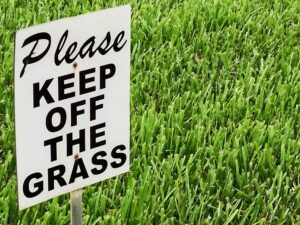So you’ve got a sad bit of lawn that is in need of some TLC. Unfortunately it can be a situation that even the most elite gardeners can find themselves in.
How best do you go about fixing the poorly patch of turf?
Prevention
It’s always better than a cure, and knocking potential problems on the head before they happen is the best way to keep your lawn healthy. It goes without saying, but a thorough lawn maintenance routine of mowing, fertilising, watering and aeration is the number one defence of your lawn’s health.
However, if it comes to pass that you do have an issue in need of attention, there are some simple steps to follow to ensure you get your lawn back on track as soon as possible.
Identify Problems Quickly
The first, and probably most important step is to identify your problem nice and early to avoid its spread to the rest of your turf.
Working out the underlying cause of your damaged grass is paramount to fixing it. Do your best to figure out the exact cause. Is it diseased? Is there too much competition for either light or nutrients from neighbouring plants? Do you have an insect issue? Or is it something as simple as an accidental spill of fertiliser?
You need to correct these issues first, or any replanted lawn efforts may be in vain.
Replacing Damaged Turf
Once any deficiencies have been corrected, it’s time to replace the already damaged turf. For this you’ll need;
A lawn mower
Rake
Grass Seed or Sod
Water
Seed Spreader (optional)
Lawn Roller (Optional
Compost or Topsoil (Optional)
Instructions for Seed Repair
- To repair lawn with seed, you first need to clear the affected area. Mow the affected area as low as you can without touching the crown of the grass, then clear the area of weeds and poor grass by digging them out. It may be easier to simply remove any plantlife, even healthy grass, from the area and start afresh.
- Use a garden rake to rough up the exposed soil, and treat it as you would the soil for an entirely new lawn. Mix in organic matter and fertiliser if possible, to give your seeds the best chance of a quick repair.
- Sow a thick layering of seed onto the area. If you’re not sure of your grass variety, or if you can’t get your hands on the exact seed you need, consult your Mckay’s rep to discuss your options.
- Water in thoroughly and often, continuing to do so until your seeds have caught up with your pre-existing turf.
Instructions for Sod Repair
Sod is pre-grown lawn that you can utilise to quickly repair a patch without having to wait for seed to sprout.
- Prepare your ground in the same way as you would for seed repair, but this time dig out the area an extra inch or so lower, to compensate for the soil and roots already formed on the sod. You need to have a strong border around the area so you know exactly what size and shape you’ll need the sod to be. If possible, spread organic matter or fertiliser into the soil prior to putting down the sod.
- Sod generally comes in the form of strips. Cut the strip into the exact shape of your bare area, and place it into the cleared patch. Butt your edges snugly up against the border of the patch to allow it to integrate seamlessly with your existing lawn.
- Use a roller or simply walk your sod in, then thoroughly water the area. Continue to water deeply and often, until the patch has blended in with the surrounding turf.
Seed vs Sod
So should you use seed or sod to repair to your damaged patch? It really comes down to your situation. Most often, the defining factor is your decision will be availability. It can be hard to get your hands on the specific variety and/or quantity of sod required to repair your lawn, while seed is often more readily available.
If you can find sod however, it can be the quickest and easiest method of repair, and if done correctly it is just as effective. To work out your options, consult your local McKays retailer.


